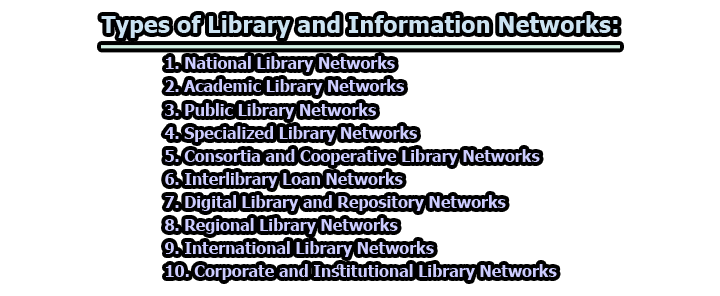Types of Library and Information Networks:
Library and information networks play a crucial role in facilitating the exchange of information, resources, and services among libraries, institutions, and information providers. These networks can be categorized into various types based on their scope, purpose, and structure. Here are some common types of library and information networks:
- National Library Networks:
- These networks connect national libraries within a country.
- They serve as the central repository of the nation’s published materials.
- Examples include the Library of Congress in the United States and the British Library in the United Kingdom.
- Academic Library Networks:
- These networks link academic libraries within a university or college system.
- They support resource sharing, collaborative collection development, and coordinated services for academic institutions.
- Examples include consortia of universities within a state or region.
- Public Library Networks:
- These networks connect public libraries within a geographic area, such as a city, county, or state.
- They facilitate resource sharing, joint programming, and coordinated services for public library patrons.
- Examples include state library networks and urban library consortia.
- Specialized Library Networks:
- These networks serve libraries with specific focuses, such as medical, law, or art libraries.
- They provide specialized resources and services to support the unique needs of their member libraries.
- Examples include medical library networks and law library consortia.
- Consortia and Cooperative Library Networks:
- These networks are formed through cooperative agreements among multiple libraries or institutions.
- They promote resource sharing, collaborative collection development, and cost-effective access to electronic resources.
- Examples include academic library consortia like the Big Ten Academic Alliance.
- Interlibrary Loan Networks:
- These networks focus on facilitating interlibrary loan services, allowing libraries to borrow and lend materials among each other.
- They enhance access to materials that are not available locally.
- Examples include interlibrary loan resource-sharing systems and networks.
- Digital Library and Repository Networks:
- These networks connect digital libraries and repositories, allowing for the sharing and preservation of digital resources.
- They support the dissemination of digitized collections, scholarly works, and open-access materials.
- Examples include the Digital Public Library of America (DPLA) and HathiTrust.
- Regional Library Networks:
- These networks serve a specific geographic region, such as a state or province.
- They provide shared library services, resource sharing, and cooperative initiatives within the designated region.
- Examples include state library consortia and regional library systems.
- International Library Networks:
- These networks operate on a global scale, connecting libraries and institutions across different countries.
- They facilitate international resource sharing, collaboration on research projects, and the exchange of cultural materials.
- Examples include the International Federation of Library Associations and Institutions (IFLA) and the World Digital Library (WDL).
- Corporate and Institutional Library Networks:
- These networks serve the information needs of businesses, corporations, and institutions.
- They provide access to specialized resources, research databases, and information services for their members.
- Examples include corporate library consortia and research institution networks.
In conclusion, library and information networks are the backbone of the global information ecosystem. They serve diverse purposes, from preserving national heritage to facilitating international cooperation, from supporting specialized fields of study to ensuring public access to resources. Each type of network plays a unique and vital role in enhancing access to information and services for users worldwide. In an increasingly interconnected world, these networks continue to evolve and adapt, furthering the mission of libraries and information providers to make knowledge accessible to all.

Assistant Teacher at Zinzira Pir Mohammad Pilot School and College










